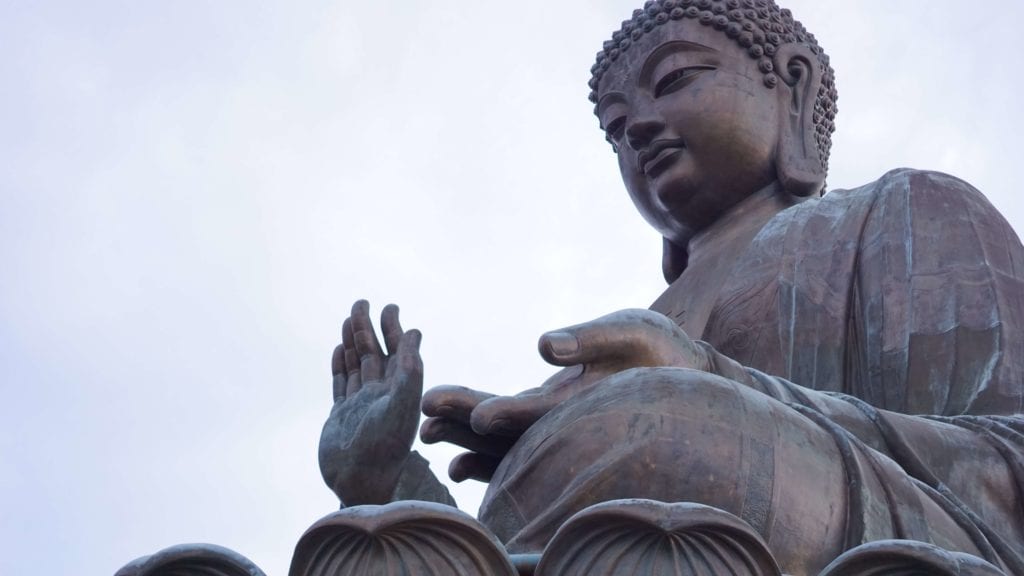We are often asked, “Where is the Buddha”? When we try to answer we may point to a statue or picture. We point outward, but the real Buddha is inside. It is our innate nature, the nature of our mind. This is true, not only of our own nature but of the nature of all sentient beings. Good or bad, angel or demon… all possess this innate Buddha-nature.
Some people say that all this Buddhist practice we do is just brainwashing! But is that the case? Rinpoche explains that in our daily lives we are already brainwashed. We spend time watching movies, watching YouTube, hearing the news, and so forth. And so much of this media that we consume– we hear, believe and take as true. Of course, it is important to stay informed. We can listen but we also can try to be moderate. We don’t just accept everything as being true. I
n this video, Rinpoche gives the example of healthy eating advice he has heard online.
Dharma Practice is About Reflecting
What is our ground?
- First… Mind
- Then… Kind
- Finally… Buddha-nature.
Where is the Buddha? Our innate nature is Buddha-nature. Is this really true? We can take time to examine and investigate. We are often so full of doubt, but in this context, we need to have certainty. We can be free from doubt and we learn through experience to be decisive.
What is blocking our certainty right now? Our clinging to the ‘dirt’ that covers this nature hides it from view. ‘Dirt’ here means the thoughts and feelings that we mistakenly believe to be our nature. But the dirt in our minds is just like dirt on our hands. Dirt is not innate, and it can be cleaned.
Dignity: Certainty in Buddha-nature
Rinpoche often uses the term, ‘dignity’ to describe this certainty in our innate nature. Our job as practitioners is to develop confidence in our true nature. Dignity is the third aspect of the ground. And dignity comes from knowing that our nature is actually Buddha.
When we hear that we have Buddha Nature it is a Mahayana teaching. Rinpoche again reminds us that ‘Buddha’ in this context is not a person, it is our nature.
Buddha Nature: Mahayana and Vajrayana
The Vajrayana path goes a step beyond the Mahayana teaching. On this path, we come to understand that our innate nature is Buddha. The Mahayana expresses Buddha-nature as like the seed of the flower. Mahayana teachings say we have the potential to be Buddha. Vajrayana teachings, say ‘I have the flower’… not just the seed. “The nature of my mind is Buddha.”
Rinpoche encourages us to repeat this daily… “Buddha means pure.” Our mind is innately pure and perfect. We will gain stability through this recollection. Moreover, we will come to see that any faults that emerge are not actually part of our nature; they are like small errors that need to be changed.
In previous teachings, Phakchok Rinpoche has discussed the first two components of the Ground. You may want to return to review these teachings!
- Mind: Knowing Mind and Practicing Dharma Continuous Journey
- Kind: Just be Kind! and Real Kindness
Reflection Exercise
It is very helpful to recollect each day on these three points:
- Mind….what is my mind? We can look at its activities and habits. Remember to do this in a relaxed and non-judgmental way — that is the first step.
- Kind… Look to see where and what kind means to you. Where am I kind? Where is difficult to be kind… why is this difficult? Again, conduct a relaxed, non-judgmental observation and inquiry.
- Buddha Nature. Recall that our innate nature is free from faults. Faults are like stains — they can be removed… they are not innate.
“The nature of my mind is Buddha” — repeat it 100 times daily.
Repeat and relax.
This will develop dignity, confidence in our true nature.










Responses